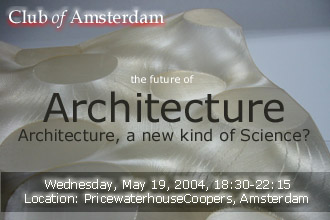
Q&A with Kas Oosterhuis

Kas Oosterhuis, Architect, Professor, Technical University Delft
Club of Amsterdam: How do you make use of real-time data in your architecture? What are the parameters you address, how do these interact with the building?
Kas Oosterhuis: All the work of ONL [oosterhuis_lénárd] is based on parametric concepts and design. Parametric design basically means the building of relations between all actors in real time. Actors are the building elements, but also the users of a building. Building relations in the end means building communication between a building and their users, between various building elements, between one building and another building, between buildings and other vehicles digesting information. Anything can connect to anything as long as they send and recieve data in real time. The parameters are created by being there and doing your thing, sensored by a variety of input devices into the communication processing system.
What is the agenda of the hyperbody research group? What specific knowledge is being developed here?
Kas Oosterhuis: The Hyperbody Research Group [HRG] main topic is to develop tools for collaborative design and engineering and prototypes for programmable architecture. The HRG uses game development software because that software is prepared to work in a multi-player fashion. many stakeholders in the design process are connecting to one continuously evolving reference model in real time. When the designer / stylist proposes a change in the geometry, the engineer will immediately see the changes in the proliferation of forces, and vice versa. Other stakeholders we are building interfaces for are: the ecologist [calculating in real time the diffusion of light and heat], and the economist [calculating in real time the costs and return on investment of the building body in progress.
Not only has the digital paradigm changed the way you conceive architecture, it’s also changing the way your projects are executed. Can you elaborate on how you regained control over a building process?
Kas Oosterhuis: ONL [oosterhuis_lénárd] has developed an effective file to factory [F2F] process to control the execution of the project. The parametric 3d model of the designer connects directly to the machines cutting, welding and bending the raw material. ONL has written in-houde special procedures, routines and scripts to extract the data from the point cloud geometry of the design proposal into a database which is scrutinized by another script at the manufacturers end. The Saltwaterpavilion [partly], th WEB , the TT Monument, and now the Cockpit and the Acoustic Barrier are all built according to the F2F process. ONL now controls both the geometry and the budget. ONL is able to build complex non standard geometries within standard budgets.
Kas Oosterhuis speaks at our Club of Amsterdam Event about
‘the future of Architecture‘ on Wednesday, May 19, 18:30-22:15!
about the future of Architecture

Archigram, the Original Blobmeister
Will Alsop: “This fantastic, hovering blob will be Archigram’s revenge for its many earlier disappointments, for competition-winning schemes that were never realised. […] And to me it is Archigram at its best. […] At last we will have a building worthy of their true spirit, albeit 35 years too late. Of course part of Archigram’s potency was its ability to initiate by going beyond what was possible, and some might argue that its ideas and messages were not intended to be built. But I believe the fact that this will be built, after so long, gives credibility to Archigram’s mid ’60s predictions. The amorphous quality of the form, internally and externally, manages to escape the language of a building type, which was one of the major points of Archigram in the twentieth century.”

SmartGeometry
The SmartGeometry Group aims to furthering advanced education and research in the area of advanced 3D CAD applications. The group is dedicated to educating the construction professions in the new skills which will be required to use new systems effectively. The SmartGeometry Group includes Lars Hesselgren (KPF), Hugh Whitehead (Foster and Partners), J Parrish (Arup Sport) and Robert Aish (Bentley) They all have background in parametric modelling as applied to architecture and their work has resulted in some of the most admired buildings of the 21st century – Swiss Re and GLA in London, the Sydney Olympic Stadium in Sydney, the Waterloo International Station.
News about the future
EU Changing City Spaces: New Challenges to Cultural Policy in Europe
“We explore new social and cultural dynamics in Europe, with particular reference to migration, xenophobia and multiculturalism. We propose that an innovative way of addressing contemporary change in Europe is through a metropolitan perspective. Our research centres on seven cities – London, Paris, Berlin, Rome, Vienna, Ljubljana, Belgrade. It addresses questions of multiculturalism within the urban space, and also the growth of new transnational flows and nexuses between cities. The empirical focus is on culture: new cultural practices, developments in cultural industries, the status of cultural policies.”
NASA’s advanced “spaceship” — Starship 2040
“Starship 2040” is a full-sized, hands-on mock-up of what a spacecraft might be like 40 years from now. The exhibit demonstrates NASA’s vision for a space-age future – based on concepts and technologies now being studied.
Housed in a dramatic 48-foot tractor and trailer rig, “Starship 2040” is touring the nation with stops at major events in several cities over the coming months. It will be open for visitors to experience future technologies and commercial opportunities in space.
Visitors will see the control, passenger and engineering compartments of a giant spacecraft and learn first-hand how NASA and its partners are building a highway to space.
Automated vehicle health monitoring systems, high-energy propulsion drives, navigational aids, safety systems and emergency systems are also featured.
International Society for Complexity, Information, and Design
International Society for Complexity, Information, and Design
The International Society for Complexity, Information, and Design (ISCID) is a cross-disciplinary professional society that investigates complex systems apart from external programmatic constraints like materialism, naturalism, or reductionism. The society provides a forum for formulating, testing, and disseminating research on complex systems through critique, peer review, and publication. Its aim is to pursue the theoretical development, empirical application, and philosophical implications of information- and design-theoretic concepts for complex systems.
Complex systems research involves investigating the origin of systems with multiple interacting parts whose collective behavior cannot be simply inferred from the behavior of the individual components. In addition, complex systems research considers how parts of a system give rise to the collective behaviors of the system, and how the system interacts with its environment. Some example problems for complex system research are:
How the neurons of the brain give rise to consciousness and other mental activitiesHow the individual parts of a society give rise to an economyHow non-life gives rise to the first living systemHow molecules control and regulate the development of whole organisms
Research in complex systems concerns the nature and consequences of interactions and non-linearities in systems of many objects. The field of complex systems cuts across all traditional disciplines of science, as well as engineering, management, and medicine. Complex systems includes topics such as artificial life, cellular automata, chaos, criticality, evolutionary computation, fractals, parallel computation, self-organization, and others.
Questionnaire about ‘the future of Healthcare & Technology
| At our recent Club of Amsterdam evening about ‘the future of Healthcare & Technology‘ we asked the audience some questions: |
| 1. Are you satisfied with the current healthcare situation in The Netherlands? |
| 33 % yes 67 % no |
| 2. Do you think the government should spend more money for ICT in healthcare? |
| 67 % yes 17 % no |
| 3. Do you agree that technology in healthcare will improve the quality of life? |
| 92 % yes 0 % no |
| 4. Should there be done more to empower the patient? |
| 100 % yes 0 % no |
| 5. Would you like health data and medical record online? |
| 83 % yes 17 % no |
| 6. Does the government – in your impression – know and follow the right path for the future in healthcare? |
| 25 % yes 67 % no |
| 7. There is new EU without borders – do you prefer also a united EU healthcare market? |
| 75 % yes 17 % no |
Recommended Book

Towards a New Architecture
by Le Corbusier
This pioneering proclamation by the great architect expounds Le Corbusier’s technical and aesthetic theories, views on industry, economics, the relation of form to function, “mass-production spirit,” and much more. Profusely illustrated with over 200 line drawings and photographs of Le Corbusier’s buildings and other important structures.
Supporter of the Club of Amsterdam event about ‘the future of Healthcare & Technology’ on Wednesday, April 28, 2004 is:


Round Table: Claudia Rodriguez

Claudia Rodiguez, founder & ceo, continea
Economics and education are the main drivers of demand for sustainable architecture and design.
Heating, cooling and lighting of buildings represent a significant portion of all energy consumed in the industrialized world. Rising resource costs and the opportunity to improve the efficiency of building energy use are creating a huge demand for sustainable building in the marketplace. In response to this demand, improved building designs make use of natural lighting and ventilation; new technologies such as efficient appliances and light fixtures reduce energy consumption; and new construction materials and processes such as high performance insulation are achieving a higher level of thermal comfort and reducing the impact of buildings on the environment and human health. Cost savings come not only from lower electric bills, but from water conservation, waste minimization, low-impact use of land and improved indoor air quality.
Education is also a key factor to moving architecture projects toward sustainability. As people become aware of the economic, environmental and health benefits of sustainable approaches they seek ways to embrace these strategies into their projects.
With the combination of high-performance design, improved efficiency, economic benefits and increased awareness, there is little doubt that sustainable building will become a more fundamental factor in the future of Architecture.
Club of Amsterdam Upcoming Events
| May 19, 2004 | the future of Architecture |
| June 23, 2004 | the future of Culture & Religion |


Leave a Reply